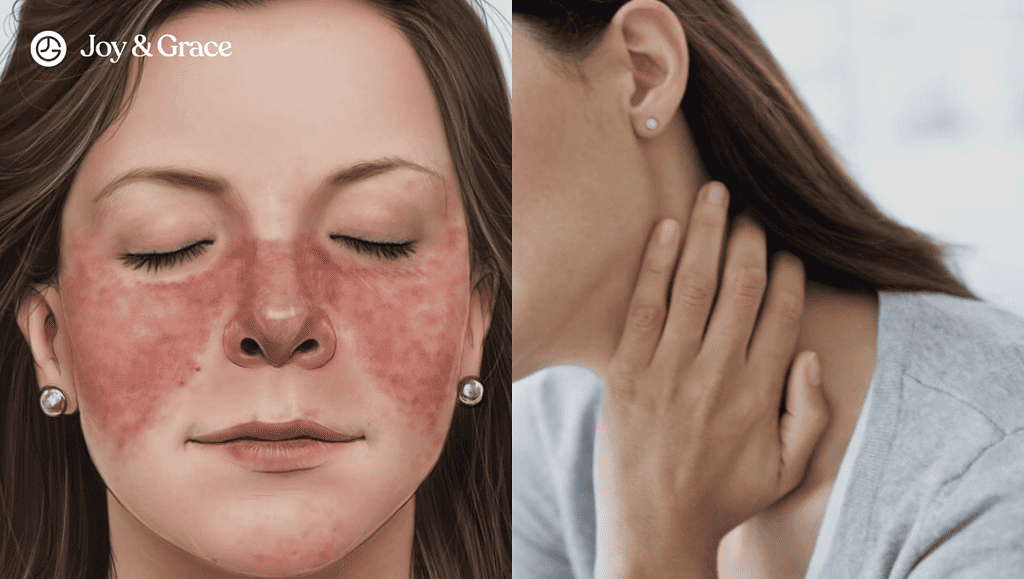Experiencing a combination of headache, neck pain, and fever can be a distressing and uncomfortable ordeal. These symptoms can arise from various causes, ranging from mild to more serious conditions. Understanding the potential underlying causes and their implications is crucial. It helps in seeking appropriate medical attention and finding relief.
What Causes Fever, Neck Pain, and Headache?
The combination of fever, neck pain, and headache is most commonly associated with meningitis.
Meningitis is inflammation of the membranes surrounding the brain and spinal cord. It is serious and requires prompt medical attention.
However, there are also some milder potential causes for this trio of symptoms.
Let’s take common viral infections like the flu as an example. They also often lead to fever, muscle aches in the neck, and headaches, creating a similar trio of symptoms.
That said, it's still impossible to diagnose the cause of any symptoms without an examination by a healthcare provider. Anytime fever is present along with headache and neck pain, it's a good idea to touch base with your doctor - better safe than sorry.
They can help determine if the symptoms are anything to worry about or simply signs of a harmless condition.
With that in mind, let's explore all the possible conditions in more detail.
1. Harmless Conditions:
Fever, neck pain, and headaches are most commonly caused by harmless conditions. Let’s review them one by one.
Upper respiratory infections:
Common colds and flu are viral infections that can cause fever, sore throats, and headaches. These infections can also lead to neck pain, both directly (by causing muscle aches) and indirectly (due to swollen lymph nodes).
Sinusitis:
Sinus infections can cause facial pain, headaches, and fever. The pain can radiate to the neck and upper back in some cases.
Stress and tension:
High levels of stress and tension can contribute to symptoms like headaches and neck pain. Add a coincidental harmless virus causing mild fever, and you have the perfect combination of headaches, neck pain, and fever.
Medication side effects:
Although rare, some medications can cause side effects like fever, headache, and neck pain. These include certain antibiotics like Cotrimoxazole.
Moving to More Serious Stuff:
A lot of times, headaches, neck pain, and fever aren’t too worrying. But sometimes, they can be signs of something more serious. It's important to know the difference between problems that might go away by themselves and those that need a doctor's help right away. Next, we'll look at some of these more serious issues.
2. Severe Conditions
While many instances of headaches, neck pain, and fever can be attributed to milder, harmless conditions, it's essential to be aware of more serious possibilities.
Let's delve into some conditions that warrant closer attention and potentially urgent care.
Meningitis:
Meningitis is an inflammation of the membranes surrounding the brain and spinal cord. Viral, bacterial, or fungal infections can cause it.
Common symptoms include a high fever, severe headache, and neck pain or stiffness. Mental changes, such as confusion or decreased alertness, can also occur. Research has shown that 26 out of every 100 patients with these symptoms have bacterial meningitis.
You are probably wondering, "Who is at risk of getting this disease?"
Well, the risk factors for meningitis can vary depending on the type of meningitis.
Some common risk factors include
- skipping vaccinations,
- age (with different age groups being more susceptible to certain types of meningitis),
- immune deficiencies, living near others in crowded settings,
- being a microbiologist working with meningococcal bacteria and
- being a traveler to the meningitis belt in sub-Saharan Africa.
The bacteria that cause meningitis are spread from person to person through nasal or throat secretions. Kissing, sneezing, or coughing on someone for a long time or living close to someone who has the disease makes it easier for it to spread.
Encephalitis:
Encephalitis is inflammation of the brain (as opposed to meningitis, which is infection of the layers of the brain). It may be caused by viral infections such as the herpes simplex virus (especially in those with weak immune systems) or mosquito-borne viruses like the West Nile virus. Along with fever, headache, and neck pain, other symptoms include:
- Confusion, agitation, or hallucinations.
- Seizures.
- Loss of sensation or being unable to move certain areas of the face or body.
- Irregular movements.
- Muscle weakness.
- Problems with speech or hearing.
Temporal arteritis:
This condition involves inflammation of the blood vessels, primarily in the head and neck. It can cause severe headaches, neck pain, and a fever.
Additional symptoms may include visual disturbances, jaw pain, and scalp tenderness. Prompt medical attention is crucial, as untreated temporal arteritis can lead to serious complications like vision loss.
3. Other Causes - Inflammatory Conditions:
Some inflammatory and autoimmune diseases can also be the cause of fever, headaches, and neck pain. These conditions cause joint and tissue inflammation, which usually also affects the whole body.
Rheumatoid arthritis:
This chronic autoimmune disease causes inflammation of the joints, including those in the neck. Neck pain and systemic symptoms like fever and fatigue can also be present.
Other symptoms include:
- Joint pain and swelling, often in the hands and feet
- Stiffness, particularly in the morning or after periods of inactivity
- Fatigue and a general feeling of being unwell
- Fever, though usually low-grade
- Neck pain, which can be a result of inflammation in the cervical spine joints
- Loss of joint function and deformities over time
- Occasional skin rashes or nodules
Lupus and Behcet’s disease
Certain autoimmune conditions, like lupus and Behcet's disease, can lead to fever, headache, and neck pain. These diseases are characterized by the immune system mistakenly attacking the body's own tissues.
- Fatigue and tiredness
- Joint pain and swelling
- Skin rashes, often on the face, wrists, and hands
- Sensitivity to sunlight
- Fever, usually mild
- Headaches and neck pain
- Chest pain when breathing deeply
- Hair loss
- Mouth or nose sores
Behcet’s disease symptoms include:
- Mouth sores
- Genital sores
- Eye inflammation
- Skin lesions
- Joint pain
- Headache and neck pain
- Fever, though it may be mild
In both lupus and Behcet's disease, the combination of fever, headaches, and neck pain often coexists with other systemic symptoms, reflecting the widespread inflammation characteristic of these conditions.
It's essential to remember that this is not an exhaustive list, and there may be other causes for fever, neck pain, and headache. It's always recommended to consult a healthcare professional. This will help you get an accurate diagnosis and appropriate treatment.
Is Neck Pain and Headache Serious?
Neck pain and headaches can be due to a range of conditions, ranging from harmless to pretty serious, as we mentioned earlier.
Some clues that help figure out how serious the issue is include:
1. Severity and duration:
For more serious conditions, the pain is generally very bad and lasts for a long time without getting better.
2. Accompanying symptoms:
The presence of systemic (whole-body) symptoms increases the risk of the condition becoming more serious. Symptoms that you should keep an eye on include:
- fever,
- vomiting,
- confusion,
- dizziness,
- visual disturbances, and
- weakness, and numbness.
If these symptoms are present, it is crucial to seek immediate medical attention.
3. Trauma or injury:
Neck pain and headaches after a significant head or neck injury should always be taken seriously and evaluated by a healthcare professional.
Examples include falls, car accidents, or sports-related incidents.
4. Underlying medical conditions:
Individuals with pre-existing conditions like rheumatoid arthritis, cervical spine disorders, or a history of cancer should be cautious of neck pain and headaches, as they may indicate disease progression or complications.
5. Age:
Neck pain and headaches can mean different things for people over 50. For example, in individuals over 50 years of age, new-onset headaches or neck pain may warrant further evaluation. It could be related to conditions like temporal arteritis or cervical spine degeneration.
What Is the Fever Range for Meningitis?
While not every fever is due to meningitis, meningitis should be suspected as a potential cause for any fever above 38°C (100.4°F)
That said, the fever range for meningitis can vary. It depends on the individual and the underlying cause of the infection.
It is also important to remember that fever alone is not enough to definitely diagnose meningitis. Other meningitis symptoms are also taken into consideration. These include:
- Severe headaches,
- stiff neck,
- sensitivity to light, and
- altered mental status.
If meningitis is suspected, it is crucial to seek immediate medical attention. The condition can progress rapidly and lead to serious complications.
What Does the Neck Feel Like With Meningitis?
In cases of meningitis, neck pain is often accompanied by stiffness. This stiffness can make it difficult to touch your chin to your chest.
However, remember that neck pain and stiffness can have various causes. Not all instances are indicative of meningitis.
Can Viral Fever Cause Neck Pain?
Yes, the viral infection causing the fever can also cause neck pain as one of its symptoms. Viral infections can affect various parts of the body. This includes the respiratory, gastrointestinal, and even central nervous systems.
Why Does Neck Pain Occur During Fever?
The viral infection causing the fever can cause neck pain through many mechanisms, including:
- Muscle Tension and Stiffness:
When a viral infection causes a fever, it often leads to generalized body aches and pains, including neck pain. - Inflammation of Lymph Nodes:
During an infection, the body's lymph nodes often become enlarged and tender as they work to filter out and destroy harmful bugs. The lymph nodes in the neck, known as cervical lymph nodes, can become inflamed and painful during an infection, leading to neck pain. - Excessive coughing
Some viral infections cause excessive coughing. The repeated coughing motions can strain the muscles and joints of the neck region, leading to pain and stiffness. The constant contraction of the throat and neck muscles during coughing fits can fatigue the muscles and exacerbate pain. - Postural Changes:
During a fever, individuals may experience changes in posture, such as hunching or tensing their muscles. This is usually done to alleviate discomfort. These postural changes can strain the neck muscles, leading to pain and stiffness. - Dehydration and Electrolyte Imbalance:
An increased body temperature often leads to increased sweating, which can contribute to dehydration. Dehydration can cause muscle cramps and spasms, including in the neck muscles, resulting in pain.
Additionally, electrolyte imbalances can occur during dehydration. This can also contribute to muscle discomfort and pain.
What Virus Causes Headache and Neck Pain?
It's crucial to understand that sometimes the same virus that causes mild flu-like symptoms in some individuals can potentially cause serious conditions like meningitis in others.
Your age, health, how strong your immune system is, and even your genes can affect how your body deals with these viruses.
On a positive note, many people only experience minor symptoms.
Let’s review some of the viruses behind headache and neck pain in more detail now.
1. Influenza Virus:
Influenza, commonly known as the flu, is caused by the influenza virus. Influenza primarily affects the respiratory system. It can also cause systemic symptoms such as headache and muscle aches, including neck pain, as we’ve been repeating throughout the article.
These symptoms are often more prominent during the acute phase of the illness.
2. Varicella-zoster virus (VZV):
Varicella-zoster virus, commonly known as VZV, is a highly contagious virus that causes two distinct diseases: chickenpox and shingles.
In its primary infection, VZV causes chickenpox, characterized by itchy, blister-like rashes all over the body.
After the initial infection, the virus remains dormant in the body's nerve cells.
Older people or people whose immune systems aren't working as well can get shingles again. Shingles is a painful rash that usually shows up on one side of the body as a band or strip.
This virus can cause meningitis and encephalitis. This mostly occurs in people with a weakened immune system.
People with a weakened immune system include those with untreated HIV, cancer, the elderly, and those taking chemotherapy drugs.
3. West Nile virus: West Nile virus (WNV):
This virus is spread by mosquito bites and mostly affects birds. People and other animals can also get it from mosquito bites.
Most people who get WNV don't have any signs or only mild flu-like symptoms. However, in rare cases, the virus can cause serious neurological diseases like encephalitis or meningitis.
Many places around the world, like North America, Africa, Europe, and Asia, have a lot of WNV. Even though there isn't a specific way to treat WNV, people can get better with supporting care like rest, plenty of fluids, and painkillers.
Taking steps to stop the spread of WNV, like getting rid of mosquitoes and using bug spray, is very important.
4. Epstein-Barr Virus (EBV):
EBV is a common virus that causes infectious mononucleosis, or mono. EBV infection can lead to headaches and neck pain in some individuals. Other symptoms of EBV are sore throat, fatigue, and swollen lymph nodes.
5. Coxsackievirus:
Coxsackievirus is a type of enterovirus that can cause various illnesses, including hand, foot, and mouth disease. A coxsackievirus infection can sometimes lead to symptoms such as headaches and neck pain.
When Should I Worry About Headaches and Neck Pain?
Various factors can cause headaches and neck pain. These include stress, tension, poor posture, or underlying medical conditions.
Most headaches and neck pains are not serious and can be managed at home.
However, there are certain circumstances when it is vital to seek medical attention. Here are some situations where you should consider consulting a healthcare professional:
- Sudden and Severe Pain:
If you suddenly have a severe headache or neck pain like never before, be cautious. This could indicate a more serious condition, such as a ruptured blood vessel in the brain (aneurysm) or meningitis. - Headache And Neck Pain After Injury:
Examples of causes of head injury include a fall or a blow to the head. These may lead to a new headache or neck pain. These symptoms could indicate a more serious condition, such as whiplash or a spinal injury. - Persistent or Worsening Symptoms:
Headaches and neck pain can persist for an extended period, increase in intensity, or worsen over time. Persistent or worsening symptoms could be a sign of an underlying medical condition. This would be a condition that requires further investigation and treatment. - Neurological Symptoms:
Other neurological symptoms may accompany your headache and neck pain. These symptoms include weakness, numbness, changes in vision, or loss of coordination. It is crucial to seek immediate medical attention in this situation. These symptoms could indicate a neurological condition or an urgent medical situation. - Changes in Pattern or Frequency:
You may notice a significant change in the pattern, frequency, or characteristics of your headaches and neck pain. Changes in symptoms could indicate a new underlying condition or the need for a reassessment of your current treatment plan.
Back To Meningitis - What Tests Confirm Meningitis?
Several tests may be used to confirm the diagnosis of meningitis and determine its cause. Here is an overview of the tests commonly used to confirm meningitis:
1. Physical Exam:
A healthcare provider will evaluate the patient's symptoms during a physical examination.
They'll look for signs of infection around the head, ears, throat, and skin along the spine.
They will also assess the patient's neck stiffness and check for other neurological symptoms.
Two common signs that suggest meningitis are:
Brudzinski sign:
Brudzinski sign is a clinical test used to assess for meningeal irritation, particularly in cases of suspected meningitis.
It involves the passive flexion of the patient's neck, which can elicit an involuntary flexion of the hips and knees.
A positive Brudzinski sign occurs when this neck flexion causes the patient's lower extremities to flex as well.
This sign indicates irritation of the meninges and is suggestive of meningitis or other conditions involving inflammation of the meninges.
Brudzinski sign is often performed in conjunction with other tests, such as the Kernig sign, to aid in the diagnosis of meningitis.
Kernig Sign:
The Kernig sign is another medical test that is used to check for swelling of the meninges, especially when meningitis is suspected.
It checks for pain and reluctance when the patient's knee is tried to be extended from a flexed position with the hip flexed at 90 degrees. If the patient feels pain and resistance during this maneuver, it means that the meningeal inflammation is making the knee stiff and limiting its range of motion, which is a positive Kernig sign. The Kernig sign and other meningeal signs help doctors figure out if someone has meningitis and decide what kind of treatment to give them.
2. Lumbar Puncture (Spinal Tap):
A lumbar puncture is a procedure in which a needle is inserted into the
lower back. This is done to collect a sample of cerebrospinal fluid (CSF). CSF is the fluid that surrounds the brain and spinal cord. Analysis of the spinal fluid can help determine if meningitis is present and whether a viral or bacterial infection is causing it.
3. Blood Tests:
Blood tests may be performed to check for signs of infection. These are an elevated white blood cell count and increased levels of inflammatory markers. Blood cultures may also be taken. They are used to identify the specific bacteria causing the infection in cases of bacterial meningitis.
4. Imaging Studies:
Imaging studies, such as a computed tomography (CT) scan or magnetic resonance imaging (MRI), may be ordered. They are used to assess the brain and surrounding structures. These tests can help identify any complications. Examples are brain swelling or abscesses, which may require immediate intervention.
5. Other Tests:
In some cases, additional diagnostic tests may be performed to determine the cause of meningitis. These tests may include viral cultures and polymerase chain reaction (PCR) testing. These detect specific viral or bacterial DNA. Serological tests may be done to identify antibodies against specific pathogens.
What Medications Treat Meningitis?
The specific medications used to treat meningitis depend on the cause of the infection, whether it is bacterial, viral, or fungal. Here is a detailed explanation of the medications commonly used to treat meningitis:
1. Bacterial Meningitis Treatment:
Bacterial meningitis is a medical emergency that requires immediate treatment with antibiotics.
The choice of antibiotic depends on the suspected or identified bacteria causing the infection. Broad-spectrum antibiotics, such as ceftriaxone or cefotaxime, are often used initially.
2. Viral Meningitis Treatment:
Unlike bacterial meningitis, viral meningitis does not respond to antibiotics. Most cases of viral meningitis are self-limiting. That means they resolve independently with supportive care.
Treatment for viral meningitis focuses on relieving symptoms and managing complications. This may include rest, fluids, over-the-counter pain relievers, and antipyretics (fever reducers). These are used to alleviate symptoms.
Sometimes, antiviral drugs may be given if the exact virus that causes meningitis is found.
Acyclovir can be used for herpes simplex virus (HSV) meningitis.
3. Fungal Meningitis Treatment:
Fungal meningitis is relatively rare but can occur in individuals with weakened immune systems. Treatment typically involves antifungal medications, such as amphotericin B or fluconazole. The duration of antifungal therapy varies but can be several weeks to months.
4. Supportive Care:
Supportive care is an essential component of meningitis treatment. This may include reducing fever, managing pain, and alleviating other symptoms.
Intravenous fluids may be administered to prevent dehydration and maintain hydration.
In severe cases, patients may require hospitalization. They are admitted for close monitoring, intravenous medications, and supportive measures.
How Long Is Meningitis Treatment?
The duration of meningitis treatment can vary depending on several factors. The factors include the specific cause of the infection and the severity of the symptoms.
Viral Meningitis Treatment:
The duration of treatment for viral meningitis can vary, but most individuals recover within a few weeks with proper rest and care.
Follow-up medical appointments may be necessary to monitor the individual's progress. It ensures a complete recovery.
Bacterial Meningitis Treatment
Antibiotic treatment for bacterial meningitis usually takes several days to a few weeks.
The exact duration will depend on various factors. These factors include the type of bacteria involved and the individual's response to treatment.
In some cases, oral antibiotics may be prescribed after the initial IV treatment to complete the course of therapy.
It is crucial to complete the entire course of antibiotics as prescribed, even if symptoms improve. This ensures complete eradication of the bacteria and reduces the risk of recurrence or complications.
Fungal Meningitis Treatment:
The duration of treatment for fungal meningitis can range from several weeks to months. It depends on the specific fungus involved and the individual's response to treatment.
It is essential to follow the healthcare provider's instructions. They provide information regarding medication dosage and duration. This ensures effective treatment and prevents recurrence.
Takeaway
Experiencing headaches, neck pain, and fevers can be uncomfortable and concerning.
While in many cases the cause is a minor illness, it's wise to see your doctor, especially if symptoms are severe or persistent. They can examine you, order tests if needed, and determine if treatment is required.
With prompt medical attention for serious causes like meningitis, outcomes are much better.
For milder issues, your doctor can suggest symptomatic relief. So don't delay if you have these symptoms - call your doctor right away. They are your best resource to accurately diagnose the problem and guide appropriate care.
Prioritizing your health and well-being is important. Stay well!















